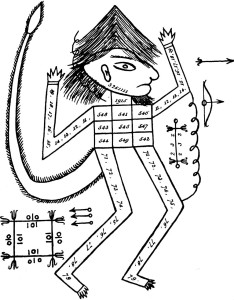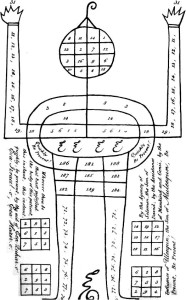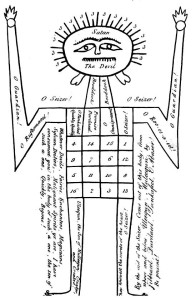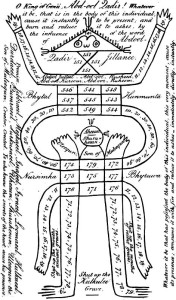

How to Turn a To-Do List into a Ta-Da List! By Craig Conley
(Craig Conley is author of HarperCollins’ One-Letter Words: A Dictionary, Weiser Books’ Magic Words: A Dictionary, and most recently The Young Wizard’s Hexopedia. His more arcane publications include A Field Guide to Identifying Unicorns By Sound, A Guide to Séance Parlor Feng Shui, and A Manual on the Care and Feeding Of A Spirit Board. In this article, he systematically extends Bob Neale’s Birth Date Magic Success Square published in An Essay on Magic, Theory and Art of Magic, 2015, pp.226-239.)
Inspiration from Secular Talismans
To be more of a wiz at your calling in life, you can employ some of the closely-guarded techniques of wizardry that “magically” empower your thoughts and expressions. These procedures are at least as old as recorded history, and because they underlie myriad belief systems, they’ll be compatible with whatever worldview you may hold (even if you consider yourself wholly unspiritual).
It may surprise you to know that a framed vestige of these methods is likely hanging in your home or office right now — a parchment emblazoned with ceremonial calligraphy, evocative seals, and the hallowed names of higher powers. A diploma is, indeed, a secular talisman complete with carefully formalized language, circular symbols of revered institutions, and the signatures of authoritative figures. As a talisman, a diploma acts in several ways: it’s an open-sesame to quite literally open new doorways to opportunity, it’s a magnet for respect, and it’s a beacon to attract affluence. A diploma is a simple, secular echo of a more elaborate set of wizardly techniques.
Handed down through generations, these wizardly ways encapsulate a technology for carefully focusing the words of your intention. You might liken the technique to a ritual or, if you prefer, a solemnity, though it’s seriously fun. In a nutshell, there is a prescribed way to thoughtfully set your goals in writing by arranging key words on a page. The meditative process is similar to “mind map” diagrams, though this technique is not about brainstorming but rather efficaciousness. Historically, to benefit from this technique you’d have to consult with your local shaman, medicine man, wise woman, or magus, who would create a talisman for you. While it never hurts to seek expert help, there are proactive ways to jumpstart your own progress. Just to be clear, the magical spirit you’ll be conjuring is your own inner being, your own highest self, via the primordial power inherent in words and symbols.
Your Own “Lamp Charm”
Let’s go old-school and use a pen and paper. The model we’ll use goes back to what was called a “lamp charm” in antiquated India, whose original purpose was to beseech the genii of the lamp, on behalf of the wise King Solomon, to burn up whatever fairy or demon was wreaking havoc. Your own talisman can appeal to the genius residing in your best self—whatever power you mustered the last time a situation felt impossible but you managed to get through it all the same. (Our vintage example appears in Qanoon-e-Islam or The Customs of the Moosulmans of India by Jaffur Shurreef and translated by G. A. Herklots, 1832.)
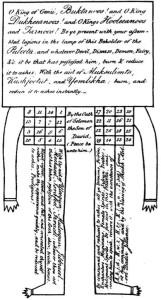
Begin by drawing the outline of a simple rectangle in the top half of your page. This shape will serve as a frame for your mission statement or a description of a problem you wish to solve. In a sentence or two, as space permits within the rectangular frame, write out what you wish to accomplish. Determine which word is the primary subject, and draw a circle around it. This process will help you to focus in just the same way that a classroom instructor circles a word on the blackboard to help students concentrate on an important point. Then determine which word is the primary predicate or action and underline it. That decision is more profound than it looks, for it is a tool of the linguists who map out what’s called the “deep structure” of transformational and generative grammar. Only when we face, pen in hand, our truest thoughts in black and white do we get to the heart of the matter. Which word points to the real subject, around which everything revolves? Which word alone stands as the springboard for the action? Even analyzing merely the subject and predicate is deep enough to clarify intentions so as to facilitate progress.
Neale’s Magic Number Squares
The next step, involving a glorified Sudoku puzzle, will pacify any yearnings to procrastinate even as it activates your non-verbal thinking. As the process will have more areas of your gray matter firing, a sudden brainstorm or problem-solving insight is likely to emerge. Dangling below your rectangular frame, make two grids of 3×3 squares (not 4×4 as in the example above). You’ll fill in these grids with very particular numbers, and the rows, columns, and diagonals of each grid will add up the same. Even mathematicians call these grids magic squares. The process is easier than it might first seem, and we’ll take it step by step, inspired as we are by the philosopher of magic, Robert E. Neale’s take on magic squares, in his book An Essay On Magic (2015, Theory and Art of Magic Press).
Since this exercise is about your personal intention, let’s make the grid quite personal by using your birth month, day, and year to determine three starting numbers. January would be a 1, February a 2, and so on. Use the last two digits of your birth year for the third number. So, for example, May 12, 1976 would give the numbers 5, 12, and 76. Make sure that all three numbers are different. Because a birthdate like December 12, 2012 would yield three 12’s, use the 2, 0, and 12 from the year (or the 20, 1, and 2) to ensure three different numbers. A zero is perfectly acceptable.
Your three birthday numbers are placed in ascending order in the top middle, bottom left, and bottom right. (Note: for this to work they must be in ascending order.) For example, a birthdate of May 12, 1976 would begin like this:
|
5 |
|
|
|
|
|
|
|
12 |
|
76 |
If you’re mathematically inclined and would enjoy the greatest challenge, determine on your own what digits belong in the rest of the grid so that every row, column and diagonal adds to the same number. If you’d like a more guided approach, the steps follow, and you can use only as many as you prefer and then figure out the rest on your own.
If you subtract the first number from the second one, you’ll have what Robert Neale calls the primary key number. We’ll refer to it later as PK. This is the key you’ll use in determining all but one of the remaining squares. For May 12, 1976, the key would be 7 (derived from subtracting the 5 from the 12).
The rest of the squares are filled in the order of the fundamental magic square:
|
6 |
1 |
8 |
|
7 |
5 |
3 |
|
2 |
9 |
4 |
But we’ll convert the numbers to letters to differentiate them from your specific numbers.
|
F |
A |
H |
|
G |
E |
C |
|
B |
I |
D |
We’ll explain the procedure for completing the square in detail below, but here’s the basic formula:
A = smallest birthday #
B = middle birthday #
D = largest birthday #
C = B + PK
E = D + PK
F = E + PK
G = F + D – C
H = G + PK
I = H + PK
There’s a slight modification in the case where the difference between A and B is the same as the difference between B and C (as in the case of 1, 3, 5), so you will want to check for that first thing. In that case, translate the year into a number that changes the difference between B and C. For instance, in the example above, 1976 could become 23 by adding all the numbers of the year together. Or it could become 13 by dropping off the century and adding the 7 and 6 together.
With that settled, we can go back to our above example of May 12, 1976—in which the difference between 5 and 12 is obviously different than between 12 and 76. So we proceed: the spaces designated A and B are already filled in, so the next space to fill is C, at middle right. Add PK (in our example, 7) to the number in space B (12). Write the result (19) in the third space:
|
5 |
||
|
19 |
||
|
12 |
76 |
As the fourth space (D) is already filled in with your largest birthday number, you’ll determine the number for the fifth space (E) by adding PK (7) to what is already in space D (76). So an 83 goes in space E:
|
5 |
||
|
83 |
19 |
|
|
12 |
76 |
You’ll continue adding PK to the center space and writing the result in the space F (at top left):
|
90 |
5 |
|
|
83 |
19 |
|
|
12 |
76 |
Now a special calculation is necessary for determining a secondary key number (SK), to be used only once, for space G (just below space F). Note the difference between the numbers in spaces C and D. That’s your secondary key number (SK). You’ll either add or subtract it from what’s in space F, and the total will go in space G. If the number in space D is larger than space C, then the number in space G needs to be larger than space F, and vice versa. So just notice the relationship between C and D and balance it by adding to F or subtracting from F as necessary. In our example, the difference between 19 and 76 is 57 (our SK), and we add that to the number in space F to get a number larger than F, or 147, which we place in space G:
|
90 |
5 |
|
|
147 |
83 |
19 |
|
12 |
76 |
If it’s easier for you to work out an addition and subtraction in one operation, you can forget about the SK altogether and simply calculate G = F + D – C.
We’re left with two spaces (H and I), which we fill in alphabetical order using PK again, in the same manner as we did for C and E in the first calculations. Just as space C was B + PK, space H is G + PK. So adding 7 to 147 means that a 154 will go in space H. And finally add PK to H to get the value for space I. So adding 7 to 154 means a 161 goes in the final space:
|
90 |
5 |
154 |
|
147 |
83 |
19 |
|
12 |
161 |
76 |
In our example, we find ourselves with a magic square in which every column and row adds up to 249.
Here’s one last wrinkle to watch out for. Sometimes the number in space C ends up being identical to that in space D. This only happens when PK and SK are identical. If they are identical, ignore our mention of SK (use PK in its place), and place the largest birthday number in space C rather than space D. Then the first calculation would go in space D rather than space C and would be C + PK instead of B + PK. So if you’ve already written the same number in spaces C and D, overwrite the number in D by adding PK to it. Then proceed to calculating E as explained above. When you come to G, just use the PK value in place of SK.
For your second grid, which you’ll be able to calculate much more easily, consider using numbers from the date at which you’d like to see your intention come to fruition. As we noted above, this numerical diversion fires up more of your brain, with a pleasing side effect: a sense of balance, of having “done the math” and seeing everything add up. By the way, the wizards of old would have sought balance not with birthdates but rather the numeral value of a key word, as in the Assyro-Babylonian numerology system of Gematria, which assigns a numerical value to each letter. For an insight into what contemporary wizards are doing, see Robert Neale’s An Essay on Magic for how to determine your “world number” and “self number” from a magic square.
Final Touches and Next Steps
All your talisman needs now is a pair of arms and legs. Upon each leg, write a sentence or two describing what would lend mobility to your wish. What would assist it to “find its legs,” or get a “leg up” advantage? On the arms, write what sort of “helping hands” would be assistive.
Feel free to festoon your design with “magic words” and key phrases that motivate, energize, or otherwise inspirit you—like confidence, growth, triumph, now, willpower, resolution, or old stalwarts like abracadabra, whatever sets the right mood.
Traditionally, some sort of sacrifice would accompany the creation of a talisman. For those of us who are animal lovers and not even good at getting blood from a turnip, why not consider making an anonymous donation to the digital tip jar of a friend or otherwise worthy cause? Make the donation just large enough as to be non-trivial to your pocketbook. In other words, don’t go for broke, but don’t be stingy, either.
Then what to do with your magical poppet? Cut it out like a paper doll and perhaps prop it somewhere in your work space where you can see it and be reminded throughout the day of your goal. Or fold it and carry it around with you in a pocket or wallet like a lucky charm. Or dream with it under your pillow. All that’s necessary, of course, is your awareness of your distilled intentions, even if only in the back of your mind. This distillation is part of the alchemical process for taking the most mundane matters and going for the gold.
For further consideration, here are four other vintage talismanic designs that might inspire your own designs. These talismans are elaborately festooned with magic words, number squares, and written intentions. They show how there’s no one right or wrong approach. Pick a design that appeals to you, complete the magic square process, and keep it no more than an arm’s length away at all times.
CLICK ON IMAGES TO SEE FULL SIZE!
